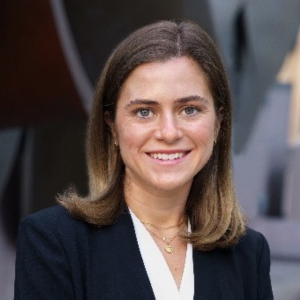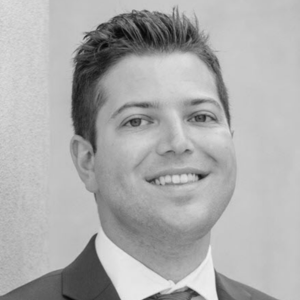California Lawyers Association
A View From the Floor: 35th Annual Golden State Institute
On October 23, 2025, the Antitrust and Consumer Protection Section was delighted to host the 35th Golden State Institute at the Hyatt Regency in San Francisco. The Section’s signature event, each year the Golden State Institute brings together thought leaders, top enforcement officials, and leading practitioners to discuss important topics in California and federal antitrust and consumer protection law. The Section was thrilled to welcome Chief Justice Patricia Guerrero as Keynote Speaker and hosted seven thought-provoking panels throughout the day, each of which are briefly summarized below by our e-brief contributors. The day concluded with a festive reception and dinner honoring Thomas Dahdouh as our 2025 Antitrust Lawyer of the Year, complete with a surprise mariachi band performance!
Recent Developments in Antitrust & Unfair Competition Law

By Alex Tramontano
Moderator: Lee Berger, Steptoe LLP
Panelists: Manish Kumar, Former Deputy Assistant Attorney General, U.S. D.O.J.; Valarie Williams, Alston & Bird LLP; Todd Seaver, Berman Tabacco
Department of Justice Antitrust Division Under the Trump Administration
Assistant Attorney General Abagail Slater now leads the United States Department of Justice (DOJ) Antitrust Division, bringing an “America First” approach to antitrust enforcement. Slater is a serious antitrust enforcer with ten years of experience as a Federal Trade Commission (FTC) antitrust enforcement attorney. While she holds conservative antiregulatory positions, her approach also includes populist enforcement goals.
Continuity in Enforcement
- The Hart-Scott-Rodino (HSR) review process will likely remain unchanged;
- The 2023 Merger Guidelines will likely stay in effect.
Policy Shifts
- Renewed openness to remedies through consent decrees (departure from prior “fix-it first” approach);
- Elimination of warning letters;
- Significant staffing changes within the division.
FTC Leadership and Direction
Andrew Ferguson serves as FTC Chair, implementing a “MAGA approach” and elevating conservative voices. The dismissal of two Democratic Commissioners is currently under review by the U.S. Supreme Court.
Labor Market Antitrust Enforcement
Labor market antitrust enforcement has emerged as a priority area under both AAG Slater and FTC Chair Ferguson. The agencies have signaled robust enforcement through updated guidelines and enforcement actions.
Notable Enforcement Actions
U.S. v. Lopez, No. 2:23-cr-00055 (D. Nev.) – The government secured its first-ever jury conviction in a labor market context. The case involved wage fixing and price fixing in Nevada, with defendants convicted on all Sherman Act and wire fraud counts.
In re Gateway Services, No. 2210170 (FTC) – This matter addressed anti-competitive practices beyond traditional wage fixing, including non-disclosure and non-compete agreements, repayment provisions, and information exchanges through third-party intermediaries.
Expanded Guidelines
The 2023 Merger Guidelines contain extensive discussion of labor markets, recognizing they are susceptible to the same competitive concerns as product and buyer markets. DOJ and FTC released replacement Human Resources Guidelines in January 2025. The guidance extends these principles with more robust enforcement signaling.
Student Athletes
In Zeigler v. NCAA, No. 3:25-cv-00226 (E.D. Tenn.), the DOJ filed a statement of interest arguing that the rule of reason should apply to restrictions in the student athlete labor market, underscoring the agency’s priority on labor market issues.
DOJ Criminal Antitrust Whistleblower Program
Initiated in May 2025, this program offers whistleblowers between 15 and 30% of the amount of the criminal fine or recovery for providing original, detailed, and timely information critical to prosecution.
Major Monopolization Cases
U.S. v. Google (Search), 1:20-cv-03010 (APM)
On September 2, 2025, Judge Amit Mehta imposed significant behavioral remedies but rejected the Department of Justice’s (DOJ) call for a breakup of the company. The court remedied the default browser arrangements while preventing Google from using its search monopoly to gain AI market advantage.
U.S. v. Google (Ad Tech), 1:23-cv-00108 (LMB)
In April 2025, Judge Brinkema ruled that Google had illegally monopolized the ad server and ad exchange markets, while rejecting the advertiser ad network claims. A two-week trial ended in October 2025. Judge Brinkema is now deliberating on a decision, which is expected sometime in 2026.
U.S. v. Visa (Monopoly Exclusion), 1:24-cv-7214 (S.D. N.Y.)
In September 2024, the U.S. Department of Justice sued Visa, alleging the company used exclusionary tactics to maintain dominance in the debit card network market. This included exclusionary contracts and agreements with Apple and PayPal preventing competitors from entering the market. In June 2025, Judge Koeltl denied Visa’s motion to dismiss the DOJ’s complaint. In October 2025, Judge Koeltl also allowed antitrust claims brought by cardholders against Visa to move forward, finding that they had adequately alleged they were directly injured by Visa’s alleged anticompetitive conduct.
Algorithmic Pricing
Real Estate:
U.S. v. RealPage, No. 1:24-cv-00710 (M.D.N.C.) – This matter examines whether AI tools that take in information and provide pricing recommendations constitute anticompetitive conduct. Key factors include whether the tool operates as a mandate or locks users into specific pricing, rather than merely making recommendations.
Hospitality:
Gibson v. Cendyn Group, No. 2:23-cv-00140 (D. Nev.) – In contrast to RealPage, this case involves AI that uses only a single company’s data and provides recommendations rather than mandates. The court found this arrangement permissible.
Healthcare:
VHS Liquidating Trust v. Multiplan, No. CGC-21-594966 (Cal. Sup. Ct. San Francisco) – In a case involving California Cartwright Act and UCL claims, the Court granted demurrer with no leave to amend, finding that reimbursement rates set via contract did not qualify as anticompetitive conduct under federal guidance.
Multiplan Health Insurer Provider Litigation, No. 1:24-cv-06795 (N.D. Ill.) – Matter involving alleged Sherman Act violations by insurers alleged to be using data to suppress reimbursement rates to healthcare providers. The U.S. Department of Justice filed a statement of interest in April 2025 supporting the plaintiffs’ legal theory. In June 2025, Judge Kennelly denied the defendants’ motion to dismiss, finding parallel pricing with plus factors adequately alleged, allowing the federal and state antitrust claims to proceed to discovery.
App Store Litigation
Epic v. Apple, No. 4:20-cv-05640-YGR (N.D. Cal 2020) – Epic successfully proved its UCL claim, which was affirmed by the Ninth Circuit. Apple was subsequently found to have violated the injunction by continuing to use “scare screens,” resulting in further relief granted on appeal.
In Re Apple iPhone Antitrust Litigation, No.4:11-CV-06714-YGR(N.D. Cal.) – Scheduled for trial in February 2026, pending motions for summary judgment and decertification.
In Re Google Play Store Antitrust Litigation, No.3:20-cv-05671-JD (N.D. Cal.) – This case involved Section 1 and Section 2 claims that Google improperly monopolized and restrained trade within the Android app markets. The jury returned a unanimous verdict in favor of Epic, finding that Google engaged in exclusionary conduct in violation of antitrust laws due to (1) its restrictions on app distribution through the Play Store and (2) its tying of in-app payments to Google Play Billing. Following the December 2023 jury verdict, the district court issued a permanent injunction in October 2024, which the Ninth Circuit affirmed in July 2025. (147 F.4th 917)
Smartphone Monopolization
U.S. v. Apple, No. 2:24-cv-04055 (D. N.J.) – Sixteen states and the U.S. Department of Justice filed a civil antitrust lawsuit against Apple for monopolization or attempted monopolization of smartphone markets in violation of Section 2 of the Sherman Act. The government seeks injunctive relief to prevent Apple from continuing the alleged anticompetitive conduct. In June 2025, U.S. District Judge Xavier Neals denied Apple’s motion to dismiss.
Merger Control Developments

By Anna Ali
Moderator: Josh Holian, Latham & Watkins LLP
Panelists: Paul Wong, NERA; Elise Nelson, NVIDIA; Tom Dahdouh
Tom Dahdouh opened the panel’s discussion by urging attendees to remember the importance of our institutions and the risks of a partisan application of the antitrust laws. He urged the federal agencies to re-focus on bringing antitrust cases and encouraged state enforcers to monitor federal merger matters, predicting that state enforcement will play an increasingly important role.
Elise Nelson, Senior Competition Counsel of NVIDIA, emphasized the importance of certainty for business teams. She noted greater predictability in merger review under the current administration—such as whether a second request is likely to come from an HSR filing—while observing increasing uncertainty globally, particularly in Europe, with a noticeable impact on global businesses. Elise also noted the importance of certainty as states increasingly consider implementing their own merger control regulations, particularly where new regulations could function as a de facto tax on in-state business. Elise encouraged in-house teams to engage with regulators early to get ahead of potential issues and provide an understanding of the business.
On nascent competition, Paul Wong, Managing Director of NERA, underscored the analytical challenges given limited case law and literature. Tom Dahdouh noted that the FTC had used retrospective studies to show anticompetitive impact and suggested additional such studies could guide courts and parties assessing nascent competition. Elise Nelson cautioned that assessing nascent competition is not a “one size fits all” situation, urging market-specific analysis of competitive dynamics. Paul Wong agreed, noting that markets evolve at different speeds and that this variation should inform forward-looking assessments.
Market Power at the Market: The Kroger/Albertsons Merger Trial Up Close

By Cheryl Johnson
Moderator: Jill Manning, JAMS
Panelists: Alexis Gilman, Alston & Bird LLP; Bryn Williams, Colorado Attorney General’s Office; Kuru Olasa, Munger, Tolles & Olson
A $24.6 billion merger between Albertsons and Kroger creating a supermarket giant with more than 5,000 stores, included stores that were dominant and close competitors in the Western U.S. Washington and Colorado sued to block the merger under their respective state antitrust laws in their state courts, while the FTC teamed with a multistate group and brought a third action in an Oregon federal court.
The panel discussed the many issues presented by multiple venue merger challenges, including differing facts, complaints and legal standards, differing rules, procedures, and timing in the various courts, resource constraints, sharing of witnesses and experts, and burdens on third party witnesses.
The pros and perils of the defense decision to not offer their own market definition and rely on criticisms of the governments’ definition of a supermarket market not including specialty grocers, Trader Joes, Amazon, Costco and other food purveyors was discussed, as was ineffective modeling to attempt to establish nonlocal boundaries of that market.
The checkered history of the proffered divestiture buyer and the parties’ own past divestitures helped doom the proffered fix and avoid a resolution of the differing standards for an effective fix. Because invocation of the common interest privilege by the merging parties can limit testimony about the fix, it must be carefully considered at the outset. Finally, the Colorado AG emphasized its handling of the merger challenge entirely with in-house staff was intended to send a strong message about the threat of meaningful state enforcement in the merger world.
Cartwright Act Reform

By Alex J. Tramontano
Moderator: Dean Harvey, Lieff, Cabraser, Heimann & Bernstein, LLP
Panelists: Eric Enson, Crowell & Moring LLP; Diana Moss, Progressive Policy Institute; David Kesselman, Kesselman Brantly Stockinger LLP
Overview
The panelists provided insight into the intentions behind the proposed changes, including comments and criticisms. Overall, the Commission is significantly advanced in finalizing revisions to the Cartwright Act, addressing both single firm conduct provisions and merger review standards.
Single Firm Conduct
Working Group Recommendations
Eric Enson discussed California’s need for a robust single firm conduct provision to prohibit anticompetitive exclusionary conduct. The Working Group considered multiple approaches, including Section 2 of the Sherman Act, the Working Group’s own recommendations, and staff proposals based on those recommendations. The consensus emerged that Section 2 does not provide sufficient protection, having been diluted by Chicago School jurisprudence. Additionally, the abuse of dominance standard carried problematic precedential baggage that hampered the Working Group’s recommendation.
Enhanced Version
Eric Enson reported that the Commission ultimately selected an enhanced version of the provision. Key issues that remain to be addressed include single firm restraint of trade scenarios and the distinction between competitive and predatory pricing. A significant concern raised is the market power threshold; without adequate definition, smaller firms could face unintended liability under these requirements.
Panel Discussion Regarding Single Firm Conduct
Diana Moss emphasized the importance of eliminating the requirement that harmed rivals demonstrate they are as efficient or nearly as efficient as the defendant. She noted the inherent impossibility of smaller market participants meeting this standard when competing against much larger defendants. Moss also raised concerns about how to distinguish harmful single firm conduct from legitimate business practices, noting that firms routinely price below cost for various competitive reasons, including market signaling and gaining market share.
David Kesselman argued against abandoning the legislation, advocating trust in the courts to interpret the law properly. He views this as an opportunity to return to the original intent of the Sherman Act, noting that California would not be bound by federal precedent on these issues. He presented a hypothetical suggesting that direct evidence of harm to competition or collusion should alleviate the burden of proving market power.
Mergers
General Framework
The Commission is evaluating whether California needs its own merger law, comparable to Section 7 of the Clayton Act. One proposal would require California to review all mergers meeting specified criteria. Concurrently, Senate Bill 25 is pending, and would require notification for transactions meeting the Hart-Scott-Rodino threshold where 20 percent or more of the business operates in California.
Four Proposed Options:
- Option 1 (SB 25): Notification required for transactions meeting HSR threshold with 20 percent or more California business presence.
- Option 2: Incorporates the Philadelphia National Bank standard (See 374 U.S. 321).
- Option 3: Similar to Option 2 but incorporates Federal Merger Guidelines and creates rebuttable presumptions where the Herfindahl-Hirschman Index (HHI) exceeds 1800 (“highly concentrated”).
- Option 4 (Appreciable Risk): Prohibits mergers that would lessen competition by more than a de minimis amount.
Panel Commentary on Merger Proposals (Lightning Round)
Diana Moss noted the absence of vertical merger guidance in current proposals.
Eric Enson advocated that states should receive Hart-Scott-Rodino (“HSR”) data to make independent determinations about merger review. He argued against adopting the appreciable risk standard in Option 4.
David Kesselman expressed doubt that the Commission will ultimately adopt Option 4.
Antitrust in Higher Education

By Delaney Brooks
Moderator: Chris Wheeler, Farella Braun + Martel LLP
Panelists: Hope Brinn, Berger Montague PC; James Crooks, Fairmark Partners LLP; Ashley K. Corkery, Cooley LLP
How the Sherman Act should regulate the activities of colleges and universities has been a hot topic in antitrust law since its inception. At the 35th GSI, this year’s Antitrust in Higher Education Panel delivered a fascinating update about recent antitrust developments on campus, from college sports to financial aid decisions.
First, we heard from Ashley K. Corkery, who brought us up to speed on the House v. NCAA settlement, which will reshape the way college athletes may be compensated for use of their name, image, and likeness (NIL). In House, a class of Division I student-athletes challenged the NCAA’s longstanding rule restricting compensation of student-athletes for commercial use of their NIL. Following five years of motion practice, the Honorable Claudia Wilken recently issued final approval in a landmark settlement resolving the case. Ashley detailed the relief available under the settlement, which includes nearly $2.6 billion in past damages to student-athletes, along with forward-looking relief requiring the NCAA to change its rules governing compensation. Case No. 20-cv-03919, Dkt. No. 717 (N.D. Cal. June 6, 2025). While the settlement will allow student-athletes to be paid for commercial use of their NIL under a revenue-sharing system moving forward, Ashley highlighted the profitability disparities that persist in athletic programs, with only men’s football and men’s basketball turning a profit. Under this new regime, only one thing is certain: the way student athletes promote themselves both on and off the field is sure to change.
Next up, Jamie Crooks turned our attention to the sidelines, with an update about the coaches’ compensation. In Smart v. NCAA, a class of volunteer coaches took aim at the NCAA’s rule limiting the number of paid coaching positions each school may employ and requiring any additional coaching positions to be unpaid. The parties recently settled, with the Honorable William Shubb approving a $50 million fund – a whopping 99% of plaintiffs’ estimated damages – that will provide back pay to the volunteer coaches. Case No. 22-cv-02125, Dkt. No. 85 (E.D. Cal. Sept. 16, 2025). Jamie described the plaintiffs’ “stupidly simple” wage fixing theory of liability, and highlighted their reliance on Judge Kavanaugh’s observation that “Nowhere else in America can businesses get away with agreeing not to pay their workers a fair market rate … [t]he NCAA is not above the law.” NCAA v. Alston, 594 U.S. 69 (2021) (Kavanaugh, J., concurring).
Finally, Hope Brinn took us into the shrouded world of college admissions, where a group of college presidents were alleged to have fixed financial aid packages at the nation’s most elite colleges and universities. Hope first laid out the history of the so-called “568 Presidents’ Group,” named for the exemption to antitrust law for colleges and universities who award financial aid packages on a need-blind basis. Plaintiffs alleged that the elite member universities of the 568 group did not qualify for the exemption, however, because their practice of admitting wealthy “development candidates” while agreeing to fix the financial aid packages of commonly admitted students was not actually need-blind, and thus constituted an illegal price-fixing scheme. Henry v. Brown Univ., Case No. 22-cv-00125 (N.D. Ill.). Hope explained that plaintiffs have reached settlements with 12 of the 17 defendant universities, with litigation continuing against the remaining five. Relief from the existing settlements, which recently exceeded $300 million, will go directly to students whose financial aid packages were negatively impacted by the 568 Group’s “consensus agreements.” While not an admission of liability, Hope noted that the 568 President’s Group has since disbanded.
In sum, all the panelists agreed that the reach of antitrust law over the nation’s institutes of higher learning is far from settled. But as each of these three settlements teach us, how students pay for college, and how they receive compensation for contributions to their schools, will continue to play out in the courts.
Antitrust Ethics in Action 3.0

By Brantley I. Pepperman
The third installment of the always-popular ethics panel provided thoughtful and informed advice on how attorneys should navigate various situations that can arise with the increasing use of artificial intelligence in the practice of law. By acting out four scenarios, panelists discussed what attorneys should—and, just as importantly should not do—when using AI:
- To prepare for and take depositions;
- To review documents for production and prepare privilege logs during discovery;
- To practice law, generally, and to operate a law firm; and
- To research, prepare, and draft legal briefs, as well as make oral argument, to courts.
In illustrating how ethical dilemmas relating to AI can arise in every-day legal situations and how to navigate them, the panelists illustrated how AI, used properly, can benefit attorneys and their clients, and, conversely, how AI, used improperly, can also result in ethical and judicial discipline and other repercussions.
Panelists included:
- Ken O’Rourke (Wilson Sonsini Goodrich & Rosati)
- Catherine Simonsen (Simonsen Sussman)
- Michael Tubach (O’Melveny & Myers)
- Qianwei Fu (Zelle)
- Stephen McIntyre (Paul Hastings)
- Paul Riehle (Faegre Drinker)
- Gary Smith (Hausfeld)
- Hanna Steinbach (Harness)
- Jill Manning (JAMS)
- Jeff VanHooreweghe (Wilson Sonsini Goodrich & Rosati)
- The Hon. Laurel Beeler (U.S. District Court for the Northern District of California)
Judges Panel

By Wesley Sweger
Moderator: Shira Liu, BRS LLP
Panelists: Magistrate Judge Alex G. Tse; Magistrate Judge Laurel D. Beeler
The judges’ panel at this year’s Golden State Institute offered an invaluable, candid, and refreshing look into how members of the bench think about antitrust cases—from the very first complaint to trial.
Magistrate Judges Alex G. Tse and Laurel D. Beeler shared practical insights on what makes pleadings effective, emphasizing clarity and storytelling over technicality. They reminded practitioners that a complaint is not only a legal document but also a first impression—both of counsel’s credibility and of the case’s narrative. A readable, well-organized complaint builds early trust with the court and lays the groundwork for future proceedings.
The panel also offered a behind-the-scenes perspective on courtroom and procedural issues that often make or break cases. From the tone of discovery correspondences to the precision of sealing requests, the judges underscored that civility and diligence matter as much as substance.
Finally, the conversation turned to trial strategy. When it comes to experts, for example, both judges encouraged practitioners to focus on clarity and persuasion rather than exhaustive detail: expert testimony, like the broader case, should tell a coherent story that a layperson can follow. Taken together, the panel offered a practical look at what judges value most from practitioners and how small choices in tone, structure, and judgment can shape the course of a case.
